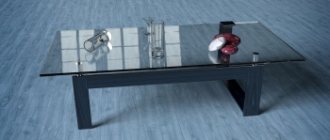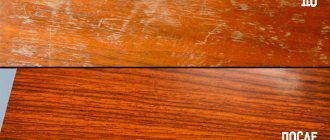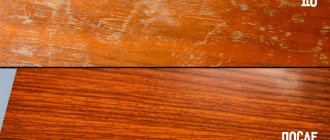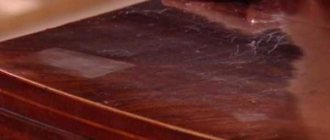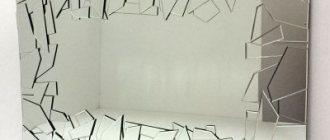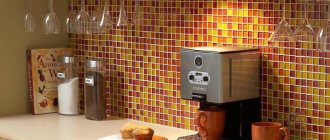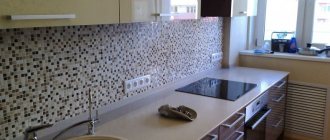Glossy kitchens are stylish and beautiful, but not entirely practical.
During use, scratches will certainly appear on the shiny surface of the cabinets. Somewhere the knife will come off unsuccessfully, or too much effort will be applied when trying to remove drops of fat. As a result, cabinet facades lose their former attractiveness and shine.
Read the article on how to safely remove scratches from a glossy kitchen surface.
Unusual solutions
The imagination of home craftsmen literally has no limits, so completely unexpected things can serve as materials for kitchen renovation.
- Photo wallpaper is a material that is in no way inferior to PVC film in terms of density and strength. It is fixed to the surface of chipboard, MDF and even plastic with liquid nails. Photo wallpapers are cut to the size of the facades and pasted in the most usual way. After the glue has dried, the products must be opened with varnish. If desired, you can order photo wallpapers with images from your personal archive.
- Tile finishing. As a rule, walls are decorated with ceramics. However, nothing prevents you from using this beautiful material as decoration for a flat or paneled facade. The tiles are cut and fixed using the same liquid nails.
- An even more interesting, but also labor-intensive option is porcelain mosaic. There are not enough broken dishes from one apartment for this, so you will have to get the fragments somewhere: if you negotiate with the nearest cafes and restaurants, you will get the material quite quickly. The fragments are sorted by color, used to form a pattern or simply a color gradient and glued to the surface of the facade. The gaps between the fragments are sealed with grout.
Restoring kitchen furniture should first of all restore functionality. However, the process is creative and exciting, so that as a result the kitchen can completely change its appearance.
Acrylic plastic
It tolerates wet cleaning well and can be treated with polish. It does not fade in the sun, does not fade and is resistant to mechanical stress.
Contaminants from such a surface can be removed quite easily. These facades can be polished when defects appear on them.
However, it is also sensitive to the chemical composition of cleaning products.
Under no circumstances should you wash them with aggressive detergents, as you may lose the shine of the glossy façade.
Glossy furniture in the kitchen interior – 50 photo ideas:
PreviousKitchenPorcelain stoneware countertops are the queen of the kitchen!
Next
KitchenHow to make a kitchen countertop with your own hands
How to clean a glossy kitchen set
Owners of glossy kitchens often have a question: how to clean a glossy kitchen set?
Today, the most popular kitchen sets are those made from bright and stylish glossy materials. This kitchen looks aesthetically pleasing and completely changes the room. Thanks to a variety of colors, even the most capricious person will find something suitable for themselves. Many people like standard white kitchens, others prefer darker tones, but the reflective properties of glossy surfaces of any color transform the room and increase visual volume.
But the owner of such a kitchen should not forget that proper care will help preserve such beauty. The owner of a glossy kitchen must have certain knowledge and comply with the conditions for proper care of it. What needs to be done to maintain the bright and shiny surfaces of such a kitchen?
A glossy kitchen has a number of advantages.
Helpful information
Tips for removing scratches from a glossy kitchen:
Restoration should begin immediately after the defect is discovered.- Before treatment, the surface is degreased. This will allow the polish to go on smoother and last longer. Alcohol can be used for this purpose. Solvents are not allowed to be used on gloss.
- To give the headset shine, first rub it with a flannel cloth and then with a dry paper napkin.
If you are interested in how to remove small and deep scratches from various surfaces and objects, take a look at this section.
Problem #1. The entire facade is stained and stained
We dare to assume that you already have a whole arsenal of detergents and cleaning products on your shelf, you constantly wash and rub your kitchen furniture, but it still has “fingers” and drops all over it. These are the first questions gloss lovers might have.
How to remove fat?
There are now many products on sale for degreasing dishes and furniture. You can even use regular Fairy, Persil and the like. Apply the gel to a microfiber cloth, lather and wipe the facades with it. Then rinse with clean water and wipe the surface dry. For the last step, it is better to use disposable rags in rolls.
Life hack: for express care of glossy furniture, you can use ordinary wet wipes, even the cheapest ones. If you walk them over your headset every day, you can avoid streaks and maintain its neat condition.
True, this method is not suitable for general cleaning. Therefore, if you fry with an open lid and splashes of fat get on the furniture, do not be lazy and immediately wipe it with a cloth before the fat “petrifies”.
What products can and cannot be used?
Remember the golden rule: under no circumstances use abrasives or substances with an aggressive composition when cleaning. A glossy kitchen cannot be washed with products that contain powder, solvent or acid - this will only erase the surface and it will become covered with small cracks and scratches.
A glossy set is very easy to spoil with cleaning powders such as Pemolux or Comet. Moreover, their destructive effect will not be immediately noticeable, but over time the gloss may become cloudy or yellow.
Products with bleach will “help” you discolor facades - such as White, Domestos, Toilet duck, Cilit Bang.
Alcohol-containing substances are also not recommended - they cause the gloss to fade and lose its original appearance.
The detergents must not contain the following components:
- alcohol;
- acetone;
- chemical solvent;
- turpentine;
- nitroglycerine;
- synthetic resin;
- chlorine.
The presence of these components may damage the glossy finish.
You can use multi-purpose cleaners such as Edelweiss, glass washing liquids (without alcohol), polishes for glossy furniture. Everything you need will shine.
Any dishwashing detergent with a degreasing effect will do.
Stores now sell special products that create a protective crystal-like film and prevent the formation of stains on glossy furniture (Amway, Ultra Gloss, VuPlex). Typically, the procedure needs to be performed every 6–12 months.
What cloth to wipe with?
Microfiber is your friend forever. You can also use flannel or flannelette fabric, disposable wet wipes, or special cloths for washing car windows, which are sold already damp in containers.
The main thing is to avoid abrasive wipes, rags and sponges with hard bristles - for example, like those on the back of a dish sponge - otherwise scratches cannot be avoided.
Use only soft cloths - they can be soaked in a 1% soap solution or washing gel. The top can be wiped with a dry cloth or paper towel.
Then apply the polishing agent with a clean cotton or microfiber cloth and leave for half an hour until completely dry. After this, rub the furniture over the furniture again with a dry cloth to remove residual white stains from the polish.
